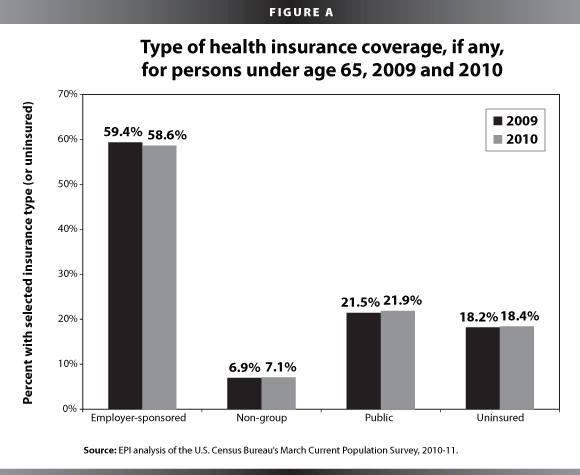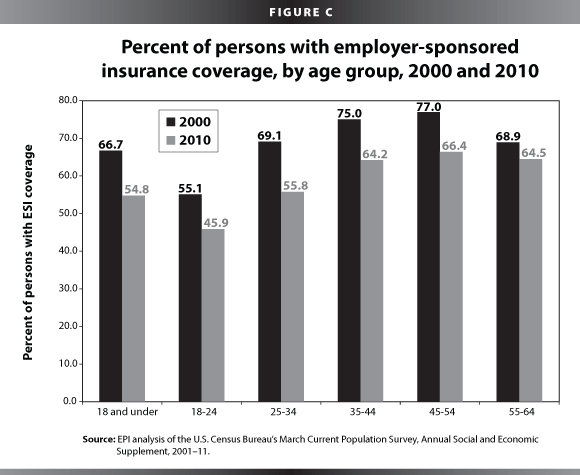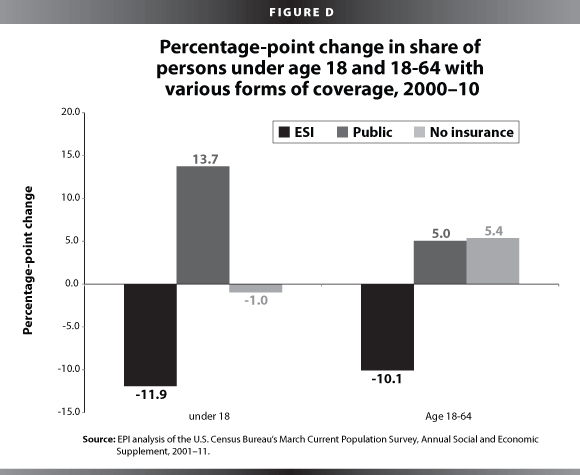According to a report released today by the U.S. Census Bureau, the number of uninsured Americans under age 65 rose from 48.3 million in 2009 to 49.1 million in 2010. When including those 65 and older, the number reached 49.9 million in 2010.
AUDIO: Listen to EPI’s press call about the 2010 report
While the Great Recession officially ended in the summer of 2009, the labor market continued to deteriorate into 2010. The unemployment rate increased from 9.3 percent in 2009 to 9.6 percent in 2010, and long-term unemployment (the unemployed without a job for 27 weeks or more) grew from 31.2 percent in 2009 to 43.3 percent in 2010. As most Americans, particularly those under age 65, rely on health insurance through the workplace, these unemployment trends make it no surprise that employer-sponsored health insurance continued to fall from 2009 to 2010. But the situation started deteriorating long before the Great Recession: Employment-based coverage for those under 65 eroded in nine of the past 10 years, including a 0.7 percentage point drop from 59.4 percent in 2009 to 58.6 percent in 2010.
Because all Americans age 65 and older have near-universal access to health insurance coverage through Medicare, this report focuses exclusively on coverage rates for the under-65 population. This report’s highlights are:
- In 2010, 49.1 million people under 65 were uninsured, up about three-quarters of a million people since 2009. The number of uninsured non-elderly Americans is 12.9 million higher than it was in 2000.
- The share of non-elderly Americans with employer-sponsored health insurance declined for nearly 10 years in a row, down from 59.4 percent in 2009 to 58.6 percent in 2010, a total decline of 10.5 percentage points since 2000.
- The only reason why the drop in employer-sponsored insurance (ESI) did not translate into a large increase in the total share uninsured is because 1.3 million more people under 65 were covered by Medicaid/SCHIP in 2010.
- Critical provisions in the Patient Protection and Affordable Care Act (also known as health reform) and the Recovery Act of 2009 helped offset the declines by insuring young adults on parent’s health insurance policies and by helping to shore up Medicaid funding.
Overall coverage trends, 2009-10
Employer-sponsored health insurance remains the predominant form of coverage for those under 65 years old. In 2010, however, the rate of coverage fell over the year (as shown in Figure A). Non-group coverage (individually purchased private insurance) increased slightly from 2009 to 2010, while public coverage rose significantly from 21.5 percent to 21.9 percent. Despite the decline in ESI coverage, this increase in the percent of Americans covered by public insurance has kept the total share without insurance from rising even faster in 2010.

A closer look at employer-sponsored insurance coverage declines
The Census report suggests evidence of further unraveling of the employer-based coverage system, as the share of persons covered through work (either their own or a family member’s employer) declined for nearly the tenth year in a row. According to the revised health insurance data, in only one year (2005) did employer-sponsored insurance rise (and then only 0.1 percentage points).
As shown in Figure B, ESI covered 58.6 percent of people under age 65 in 2010, down from 59.4 percent in 2009, and a total decline of 10.5 percentage points since 2000.

Figure C illustrates the incidence of employer-sponsored health insurance across various age groups from 2000 to 2010. Prime working-age adults (25-54) consistently have the highest workplace coverage rates, while young adults (18-24) have the lowest. Losses were in excess of 10 percentage points over the decade for all groups except the near elderly and young adults. Those aged 55 to 64 have continued to have high and rising labor force participation rates, leading to lower declines in employer-sponsored insurance for this group. For young adults, health reform played a key role in stemming the fall of workplace coverage, though the decline was still substantial.
The Patient Protection and Affordable Care Act included provisions that allowed young adults up to age 26 to secure health insurance coverage through their parents’ employer-sponsored health insurance policies. Between 2009 and 2010, the only age group that experienced statistically significant increases in overall coverage was 18-24 year olds. Their uninsured rate fell a significant 2.0 percentage points. While the number of uninsured people under 65 rose by over three-quarters of a million, the number of uninsured between 18 and 24 years old actually fell half a million.

ESI coverage for children continued its unabated decline, falling again between 2009 and 2010, from 55.8 percent to 54.8 percent. The coverage of children through the employment-based system has fallen 11.9 percentage points since 2000. The total share of uninsured children did not statistically change over the last year, however, as their Medicaid/SCHIP rates continued to rise, increasing from 33.8 percent in 2009 to 34.8 percent in 2010.
Over the decade, it is clear how public insurance has shielded children from the declines in employer-sponsored insurance. As shown in Figure D, the percent of children with employer-sponsored health insurance dropped 11.9 percentage points from 2000 to 2010, while the percent with public insurance rose 13.7 percent (primarily due to Medicaid/SCHIP), ultimately leaving fewer children uninsured. In part, the security of the safety net was protected from significant cuts by the federal government’s Recovery Act aid to states.
The Recovery Act of 2009 included significant state aid that lessened the need for states to make cuts to services and spending, or increases in state and local taxes. A large percentage of the state aid was in the form of increased Medicaid funding to reduce the extent and severity of cuts to that program. While it is impossible to know what would have occurred had states not received Recovery Act funds, it is clear that those funds did help maintain and increase Medicaid coverage.
Non-elderly adults have not been so fortunate. The 18-to-64-year-old population experienced a statistically significant increase of 13.3 million more uninsured adults from 2000 to 2010.

Conclusion
The data released September 13, 2011 by the U.S. Census Bureau highlight the fact that the current system does not provide stable and secure coverage for many Americans. The share of Americans under age 65 with employment-based health coverage fell for nine out of the last 10 years, dropping from 69.2 percent in 2000 to 58.6 percent in 2010. The percent of uninsured Americans under age 65 rose from 14.7 percent in 2000 to 18.4 percent in 2010. The declining share of Americans with employer-sponsored health insurance and the associated rise in the total uninsured over the 2000s are trends that will worsen in the near future. Fortunately, the phase-in of the Patient Protection and Affordable Care Act over the next few years should eventually stem any additional losses and reverse the current trend, covering millions more Americans.
Research assistance by Nicholas Finio
